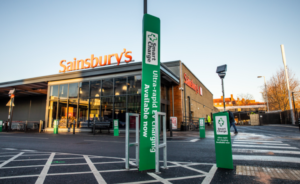Advertorial: How Yunex Traffic systems are benefitting School Streets schemes
Back in 2020, the UK Government set out its vision for a travel revolution in our towns and cities, with the publication of ‘Gear Change – A Bold Vision for Cycling and Walking’. The initiative encouraged and empowered local authorities to create better and safer environments for pedestrians and cyclists.
Now two years on, we have seen many projects come to fruition, with numerous School Streets, Low Traffic Neighbourhood and segregated cycle lane schemes having been commissioned.
The rapid growth of School Streets schemes continues, particularly around primary schools where they are proven to not only reduce road danger but also improve air quality in the immediate environs of the school. They have also shown how they encourage behavioural change, with many more parents and children now choosing to walk or cycle to school, improving physical health and mental wellbeing in the process.
In March this year, The Mayor of London, Sadiq Khan, spoke about the success of London’s School Streets programme, announcing that over 500 School Streets schemes are now in operation – accounting for almost a quarter of primary schools.
The Mayor said: ‘For London to become Net Zero by 2030, we need to reduce motor traffic by a third. The school run accounts for a quarter of morning traffic, so School Streets are a key tool in helping to drive down congestion, air pollution and road danger. They are making a massive difference to our capital’s communities, with more than half of London’s 5-11 year olds now walking to school.’

First introduced in 2015, a School Street zone draws on powers given to Local Authorities under the Road Traffic Regulations Act to turn a street into a pedestrian and cycle zone. During the key drop-off and pick-up periods in term time, temporary restrictions are imposed and enforced on both school and through traffic on a road (or roads) outside a school, to provide a safer and healthier school environment.
According to a report commissioned by campaign group Mums for Lungs and environmental charity Possible in January 2021, two-thirds of schools in London, Birmingham, Leeds and Bristol have the potential to implement a School Streets scheme. As a result, based on average car emissions, a roll-out of School Streets in these four cities alone would have the potential to reduce carbon emissions by up to 12,000 tonnes per year (enough to fill the Gherkin in London 22 times).
Evidence from the first four schools to benefit from School Streets schemes in the London Borough of Hackney showed that traffic reduced on average by 68%, the number of children cycling to school increased by 51% and vehicle emissions outside schools (nitrogen oxides, and particulate matters PM10 and PM2.5) fell by 74%.
To date, the vast majority of these schemes to have been installed are in and around London, leaving school children in the rest of the UK unable to benefit from cleaner air and safer travel to and from their school. This is largely because up until now, local authorities outside London have not had the powers to enforce moving traffic offences, including School Streets, with enforcement responsibility in these areas sitting with the police.
As a result, the only real option outside London has been for local authorities to implement physical barriers such as bollards or removable gates to enforce a temporary road closure, solutions which are much less sophisticated and less flexible than an ANPR (Automatic Number Plate Recognition) camera-based system and which can delay the emergency services.
However, following the full introduction of Part 6 of the Traffic Management Act 2004 this year, civil enforcement of a wide range of moving traffic offences is now back into the hands of the local authorities, who understand best how their authority areas are likely to benefit from intervention schemes.

This enables councils outside London to implement not only School Streets schemes, but also a range of other measures that draw on ANPR camera technology – including banned turns, no vehicle entry, yellow box junction offences and incorrect driving in bus lanes.
Yunex Traffic LaneWatch ANPR enforcement systems have been deployed by many authorities and feature robust and reliable equipment which is quick to install to minimise disruption.
The designated School Street area is typically just one road with a camera at the start and end of the zone, but multiple roads can be covered by the installation of more cameras. Each camera is configured to monitor vehicles entering the area during specified periods, as part of a seven-day configurable schedule of enforcement.
The system identifies potential contraventions in real-time, with video evidence recorded to give a contextual overview, and still images capturing each vehicle’s registration plate. The overview video allows the system operators to establish if there are any extenuating circumstances for the contravention. LaneWatch cameras are also fully redeployable, so are an asset that can be used to enforce other moving traffic offences if required.
Whilst the well documented and much publicised Clean Air Zones have proven to provide significant and immediate positive impacts to the air quality in cities across the UK, the results from School Streets schemes in London show just how effective these smaller, more local enforcement programmes can be in driving behaviour change and make a major contribution to improving road safety, air quality and the health and wellbeing of our children in particular.
Photos by Yunex Traffic
















